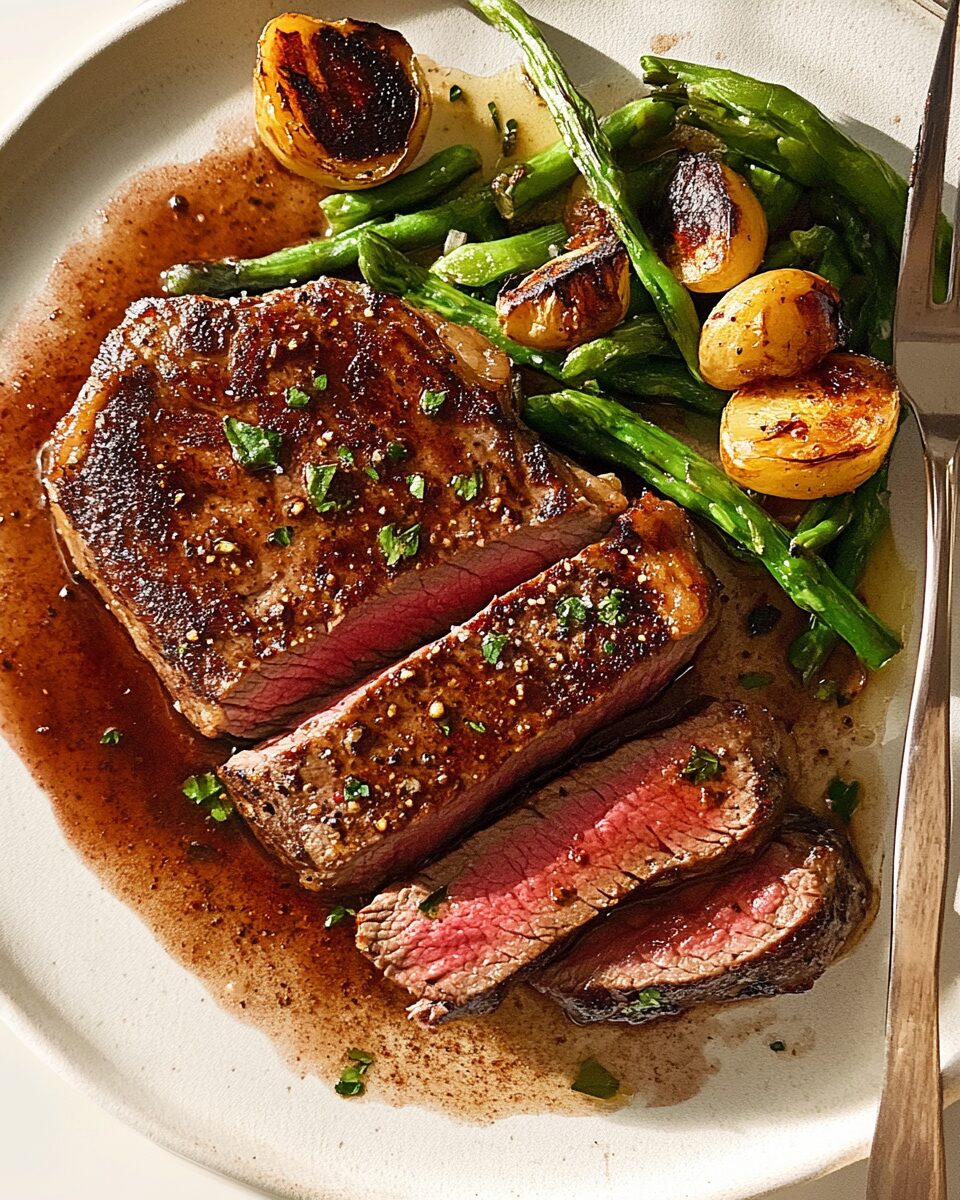When it comes to steaks, most people immediately think of cuts like ribeye, filet mignon, or New York strip. However, there is another cut that has gained popularity among budget-conscious home cooks and chefs alike—the chuck eye steak. Often referred to as the “poor man’s ribeye,” this cut offers the tenderness and flavor of a ribeye steak but at a fraction of the price. In this article, we will delve into what makes chuck eye steak a fantastic choice for your next steak dinner, explore its characteristics, cooking techniques, side dish pairings, and provide tips to help you achieve the best results. Finally, we’ll conclude with insights on why this particular steak deserves a spot on your dining table.
Full Recipe:
Ingredients:
- 4 (8 ounce) beef chuck steaks, well-trimmed and at room temperature
- Salt and freshly ground black pepper to taste
- 2 tablespoons olive oil, or as needed
- 3 tablespoons butter (divided), or more as needed
- 2 sprigs fresh thyme (optional)
- 2 cloves garlic, crushed
- 1 shallot, minced
- 1/2 cup beef broth
Directions:
- Pat steaks dry with a paper towel. Season generously with salt and pepper.
- Heat oil in a skillet over high heat. Add steaks to the hot skillet, then turn the heat down to medium-high. Cook for 4 minutes.
- Flip the steaks, add 1 tablespoon of butter and thyme sprigs to the pan, and cook for another 4-6 minutes, depending on your preferred doneness.
- Remove steaks and let them rest for about 5 minutes.
- While the steaks rest, make the pan sauce:
- Sauté the garlic and shallot in the skillet using residual heat for 1-2 minutes.
- Return skillet to medium-low heat, add beef broth, and bring to a boil. Reduce for about 3 minutes.
- Remove the pan from heat and whisk in the remaining 2 tablespoons of butter. Serve the sauce over the steaks.
Nutrition (per serving):
- Calories: 780
- Fat: 56g
- Carbs: 4g
- Protein: 65g
The Chuck Eye Steak: Origins and Characteristics
The chuck eye steak is cut from the shoulder or chuck primal of the cow, specifically from the area near the ribeye. The closer it is to the rib section, the more tender it is, which is why chuck eye steaks are often likened to rib eyes. Though it comes from the tougher chuck section, the chuck eye benefits from its proximity to the ribeye muscle, offering a similar texture and rich, beefy flavor.
A common question among steak enthusiasts is how the chuck eye compares to more expensive cuts. The key difference lies in the muscle fibers. Ribeye steaks are cut from the sixth to twelfth ribs, where the muscles are less worked and thus more tender. The chuck eye is cut from the fifth rib, making it slightly less tender but still packed with flavor and marbling.
What makes the chuck eye truly special is that it offers the best of both worlds: tenderness akin to a ribeye with a hearty, beefy punch from the chuck section. Its affordability makes it an excellent choice for those who want a high-quality steak without breaking the bank. Moreover, with the right cooking technique, you can bring out its full potential.
Cooking Chuck Eye Steak: The Perfect Sear
The hallmark of a well-cooked steak lies in the technique, and chuck eye steak is no exception. Since this cut is a bit tougher than ribeye, it benefits from a high-heat cooking method like searing, which creates a crust that seals in the juices. Searing at high temperatures caramelizes the steak’s exterior while maintaining its juicy, tender interior.
A heavy skillet or cast-iron pan works best for this process, allowing you to get that beautiful golden-brown crust while controlling the heat. Unlike some more delicate cuts, chuck eye steak stands up to strong seasonings, so feel free to be generous with salt, pepper, and any additional herbs like thyme or rosemary. The key to cooking chuck eye steak is to let it rest after searing to redistribute the juices, making every bite tender and succulent.
A pan sauce is often made from the drippings left in the skillet after cooking the steak, further enhancing the flavor. You can use ingredients like garlic, shallots, beef broth, and butter to create a rich sauce that complements the steak perfectly. This method not only adds depth to the dish but also ensures that none of the delicious steak juices go to waste.
Tips for the Perfect Chuck Eye Steak
Though chuck eye steak is relatively easy to cook, a few key tips will help you elevate it to restaurant-quality:
- Bring the steak to room temperature: Allow the steak to come to room temperature before cooking. This ensures even cooking throughout and prevents the steak from being cold in the center while overcooked on the outside.
- Pat the steak dry: Removing excess moisture before searing helps achieve a crispier, more flavorful crust.
- Use high heat: A hot skillet is essential for searing. Make sure your pan is properly preheated before adding the steak. If you drop the steak into a cold pan, you won’t get that signature crust.
- Baste with butter: Towards the end of cooking, adding butter to the pan and basting the steak with it can enhance the flavor. The butter adds richness, while herbs like thyme or rosemary impart an aromatic finish.
- Rest the steak: After searing, it’s essential to let the steak rest for about 5 minutes. This allows the juices to redistribute, ensuring a moist and tender result.
- Don’t overcook: Since chuck eye steak is slightly less tender than ribeye, it’s best served medium-rare to medium. Overcooking can result in a chewy texture.
Ideal Side Dishes for Chuck Eye Steak
No steak is complete without the perfect sides. Because of its rich, beefy flavor, chuck eye steak pairs well with classic steakhouse accompaniments as well as lighter options that balance out the richness of the meat.
- Roasted Potatoes: Simple, crispy roasted potatoes are a classic choice for steak. Their crispy exterior and soft, fluffy interior make them the perfect vehicle for absorbing the flavorful steak juices and pan sauce.
- Asparagus: A side of roasted or grilled asparagus adds a fresh, slightly bitter contrast to the steak’s richness. Drizzle with olive oil and sprinkle with salt and pepper for a simple yet elegant side.
- Sautéed Mushrooms: Earthy mushrooms sautéed in butter or olive oil with a touch of garlic pair beautifully with steak, enhancing its umami flavors.
- Creamed Spinach: For a more indulgent option, creamed spinach provides a rich, creamy counterpoint to the hearty steak.
- Mashed Potatoes: Silky mashed potatoes, seasoned with butter and garlic, make an excellent side dish. They soak up any sauce or juices from the steak, ensuring that every bite is flavorful.
Variations and Pairings
The versatility of chuck eye steak lends itself to a variety of culinary adaptations. For example, you can experiment with different marinades or spice rubs to introduce new flavors. A garlic and herb marinade adds freshness, while a spice rub with cumin and paprika brings a smoky, earthy tone.
Additionally, while this recipe focuses on searing, chuck eye steak also lends itself well to grilling or broiling. Grilling adds a smoky flavor, perfect for summer cookouts, while broiling is an excellent option for those who want a crisp, caramelized crust without using the stovetop.
When it comes to sauces, the possibilities are endless. In addition to the traditional pan sauce, consider serving the steak with chimichurri, a bright, herbaceous Argentinean sauce made with parsley, garlic, olive oil, and vinegar. Alternatively, a blue cheese butter can add an extra layer of richness and sophistication.
Conclusion
Chuck eye steak may not have the same recognition as ribeye or filet mignon, but it’s an excellent option for steak lovers who want a high-quality cut at an affordable price. Its rich, beefy flavor, combined with the right cooking techniques, can result in a meal that rivals more expensive steaks. Whether you’re searing it in a skillet or grilling it outdoors, chuck eye steak is a versatile, flavorful cut that’s perfect for a range of occasions, from casual weeknight dinners to special gatherings.
Pair it with classic steakhouse sides like roasted potatoes and asparagus, or switch things up with sautéed mushrooms and chimichurri for a global twist. No matter how you serve it, chuck eye steak is sure to impress.
So next time you’re in the mood for a steak but don’t want to splurge on a ribeye, give chuck eye steak a try. With a little attention to detail and some simple cooking tips, you can enjoy a restaurant-quality steak at home without the hefty price tag.






